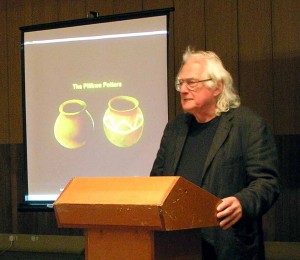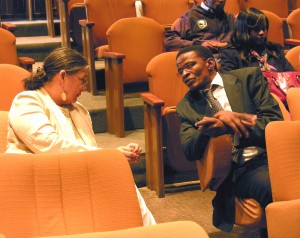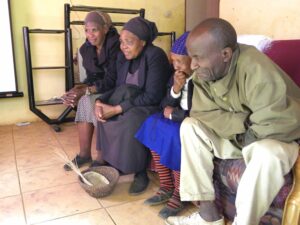Engaged Anthropology Grant: Ed Wilmsen and ‘Pottery, Clays, and Lands: An Ethnoarchaeological Study of the Social Dimensions of Pottery in Botswana’

Ed Wilmsen is Honorary Fellow of the Centre for African studies in the School of Social and Political Science at the University of Edinburgh. In 2013, he received a Post-Ph.D. Research Grant to aid research on ‘Pottery, Clays, and Lands: An Ethnoarchaeological Study of the Social Dimensions of Pottery in Botswana’. Last year he received the Engaged Anthropology Grant to aid engaged activities on ‘Reciprocal Relations: Expanding the Benefits of Research in the Study Area’ in his former field site of Botswana, working with local potters to increase exposure for their wares, and holding film screenings and seminars to share research with the local populace as well as professional archaeologists.
The initial museum seminar on June 10 included the Director of the Archaeology Unit plus other personnel and was focused mainly on recurrent concerns about the relevance of ethnographic observations for interpreting archaeological data as well as on the potential impact of new legislation regarding access to mineral resources. Clay is specifically included in this legislation, but the very loose wording of the document makes it unclear if it applies to small scale operators such as the village potters with whom we have been engaged. Two subsequent UB seminars included Professor Kalabamu, Head of the UB Department of Architecture and Planning, Professor Boipuso, Head of the Department of Civil Engineering, both of whom are actively engaged with developments in minerals and more generally proposals concerning access to resources, as well as Professor Fred Morton (UB History) and visiting Professor Coulson (University of Oslo Archaeology) who has many years experience in the country. The consensus reached at all these meetings was that future free, or affordable low cost, access to raw materials by potters could be in jeopardy and urgent steps must be taken to clarify the matter. Wilmsen and Griffiths subsequently consulted Dr. Jeffress Ramsay, Director of Communications in the Office of the President and a doctoral student of Wilmsen, who informed us that this matter was recognized and steps were being considered to exempt small scale producers under specified conditions. Nonetheless, this remains a matter of concern and needs to be monitored.
Another matter of considerable concern was voiced particularly by a curator in the National Museum Ethnography Section. This is that, although pottery making in Botswana is undergoing a significant revival, there is an increasing tendency for potters to adopt mechanical, mainly foot or electric powered potting wheels, rather than traditional modes of manufacture. The fear is that a significant facet of Tswana heritage will be lost to future generations, and the question is how to stimulate sufficient interest – not only among producers but also purchasers – to sustain these traditional modes.

The workshop took place in the Little Theater of the National Museum and was opened with welcoming remarks by Mr. Louis Moroka, Deputy Director of Archaeology. Wilmsen then gave a brief overview of the genesis and progression of our work with potters including a history of its funding by Wenner-Gren and others. This was followed by the screening of the film. Griffiths then discussed the key social features depicted in the film including traditional and contemporary constraints on resource procurement as aspects of land tenure. After which Wilmsen explained the technical steps taken by Pilikwe potters in transforming rotted granite into clay and the analytic procedures we use to trace potting materials to their geologic source and how such data aid in identifying prehistoric social interactions. Thebe summed up the foregoing in relation to common problems in ethnographic and archaeological research.
The workshop was attended by a total of 54 individuals prominent among whom was Mr. Kebalo Manase, Registrar of the National Land Tribunal, UB professors and students as noted above, all museum research staff, representatives of several Botswana CRM organizations, Botswana Society members, as well as media reporters/photographers including Ms. Rosalind Kwenye, Editor of Women-to-Women magazine. A lively discussion followed the presentations with the principal issues summarized above receiving the greatest attention; personal discussions continued for some time over tea and biscuits in the museum courtyard.

Village visits
The village visits produced some surprises, with most of these at Pilikwe. Five of the potters in this village with whom we worked in 2006-2013 were able to meet with us: Gobotsamang Motonto, Fred Motonto, Balemogeng Motswapong, Batlhalefi Gaobatlelwe, and Gathanang Galenamongwe. The oldest, Dineo Batsalelwang, has died, and Otsetswe Senonki’s son is in Palapye hospital where she is staying with him. The youngest two, Moipone Oatametse and Omphile Kakwanda, have taken jobs in Palapye. This reflects substantial changes taking place in the village where major (relative to the area) infrastructural upgrading by District Council is taking place. The women who met with us continue to make pots and wish to be able to increase their output but are restrained by lack of access to materials and markets. They pointed to our 2010 article on their potting in the Air Botswana inflight magazine Peolwane which had brought several tourists to Pilikwe who bought many pots; we were given a new pot in gratitude for this. Their response to our tale of museum fears for the loss of traditional pot-making was amusing – but telling: “we don’t want to stay ‘traditional’, we want production”, and specified a foot-powered potting wheel and a motor-powered clay grinder as most desirable. Nonetheless, as their rapt attention to our film testifies, they still have a deep interest in their traditional ways.
The situation in Manaledi could hardly be more different. There traditional potting is thriving, and Mma Lebonetse has a young apprentice, her niece, Galeboeng, and five other potters have their entire cash income from potting. The reasons for this difference are largely a matter of geographical location. Pilikwe is being absorbed in the periphery of the Palapye labor catchment area. Palapye is now called “Botswana’s Powerhouse” because all electricity generating takes place here, all north-south-west highways and railways intersect here, and the Botswana Institute of Science and Technology with 800 students opened two years ago. This has brought a newly repaved, widened road to Pilikwe with regular bus service between Pilikwe and Palapye just 34km away; consequently, new employment opportunities have appeared as Moipone and Omphile can testify. Traditional ways, especially if they entail heavy work as does old style potting, tend to seem less desirable. In contrast, Manaledi is 65km from Palapye; about half this distance is on a narrow road paved to the village turnoff from whence it is a dirt track. There is no electricity and no public transport. On the positive side, Manaledi potting clay is a short walk away and donkey carts are readily available to haul the load home. Under such conditions, traditional ways seem normal. Manaledi potters do want more market exposure and among our plans for the future are to devise ways to accomplish this.
Addendum
In addition to the Wenner-Gren funded engagements,Griffiths was able to schedule a supplementary meeting of her Law and Commerce class in the graduate program in Women and Law at the University of Zimbabwe in early July at which we screened our film and followed this with a lengthy discussion session.